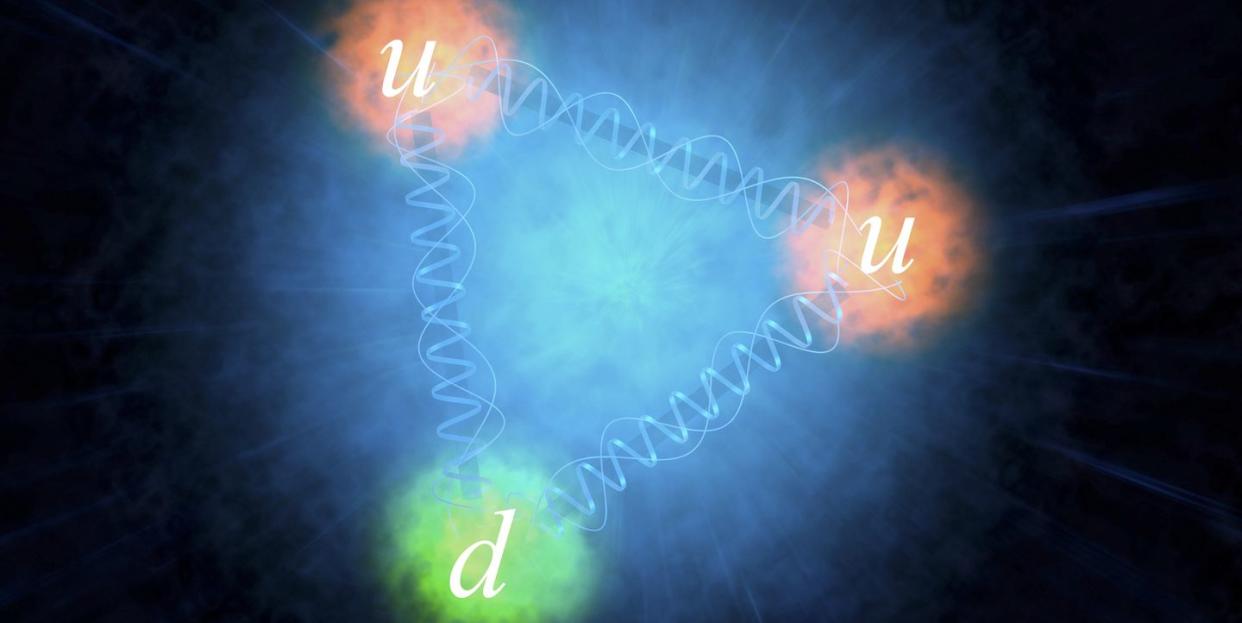For All This Time, Protons Have Been Hiding Secret Mass. We Just Found It.

"Hearst Magazines and Yahoo may earn commission or revenue on some items through these links."
Researchers just found out where the secret mass of protons is located.
Physicists have long known that protons are more massive than the stuff that makes them up, but we didn’t know where that mass was located in the particle.
It turns out, it was right in the center of the proton this whole time.
Usually, when we talk about mass, we’re talking about how much stuff is in an object. Everything from your body to a black hole is made up of matter, and adding all that matter together gives you the mass of an object.
But, just like everything else, mass can get a little screwy in the quantum world. Physicists have been puzzling over why protons are more massive than the matter that makes them up for a long time, and recently, they seem to have figured it out.
Protons are physically made up of three smaller pieces called valence quarks, the absolute fundamental constituents of matter. They're not made of anything else—a quark is as small and basic as you can go. But adding up the mass of the quarks alone doesn’t give you the mass of the proton.
Over the course of several decades, researchers have pieced together what makes up the rest of the mass. First, the movements of the quarks actually produce mass. Second, mass is generated by the force holding all the quarks together. Known as the strong force, it manifests as something called “gluons.” And finally, interactions between the quarks and the gluons produce the rest of the mass.
If you think a lot of this sounds more like energy than mass, just remember our good old friend, e=mc2.
So, over time, we’ve pretty much theorized out what is creating all this extra mass that “shouldn’t be there.” But even though we’ve known it exists, we haven’t been able to pinpoint where it’s coming from. You wouldn’t think much could hide in a space as small as a single proton, but this bonus mass has proved that thought wrong for a long time.
In a recent paper, however, scientists were finally able to do just that. While one might think that this secret mass would be sort of spread throughout the proton, it turns out it’s all been hiding right in the center this whole time. Researchers were able to determine a “mass radius” that was much smaller than what’s called the charge radius—the measurement usually used to define the size of a particle. Particles like protons don’t have hard boundaries, so it’s a bit tricky to measure them.
The experiment that delivered this result was complicated, but then again, particle physics experiments are rarely simple. This one involved shooting a beam of electrons at a block of copper, causing those electrons to emit packets of light—called photons—that then hit a bunch of protons in a tank of liquid hydrogen.
Some of those photon-proton interactions produced particles called J/psi particles, which are made up of pairs of charm/anti-charm quarks (quarks have weird names—one variety is actually named “strange”) and rapidly decay into pairs of electrons and positrons.
There are a lot of particles and decays to track, but it all comes together. By focusing on just the interactions that produced these J/psi particles, researchers were able to determine the radius of those strong-force gluons instead of the overall charge radius of the proton. And that gluon radius is the mass radius in which all that bonus proton mass was hiding from us for decades.
When the researchers ran those numbers through somehow even more complicated computer models, they were able to also confirm how much of this new bonus mass was taken up by different types of gluons.
Moving forward, researchers hope to further probe the physics of J/psi particles. But considering that the scientists who made this discovery were looking for something else entirely and discovered this result by accident, it seems like they’re already coming out ahead.
"The bottom line for me—there's an excitement right now. Could we find a way to confirm what we are seeing? Is this new picture information going to stick?” Zein-Eddine Meziani, staff scientist at DOE's Argonne National Laboratory and experiment co-spokesperson, said in a press release. "But to me, this is really very exciting. Because if I think now of a proton, we have more information about it now than we've ever had before."
You Might Also Like

